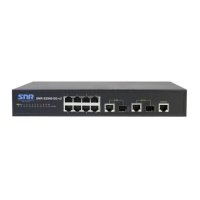SNR S2940-8G-v2 Switch Configuration Guide
MAC Table Configuration
1. Forward data according to the MAC table
If PC1 sends a message to PC3, the switch will forward the data received on port 1/5 from port
1/12.
2. Filter data according to the MAC table
If PC1 sends a message to PC2, the switch, on checking the MAC table, will find PC2 and PC1
are in the same physical segment and filter the message (i.e. drop this message).
Three types of frames can be forwarded by the switch:
• Broadcast frame
• Multicast frame
• Unicast frame
The following describes how the switch deals with all the three types of frames:
• Broadcast frame: The switch can segregate collision domains but not broadcast domains. If
no VLAN is set, all devices connected to the switch are in the same broadcast domain. When
the switch receives a broadcast frame, it forwards the frame in all ports. When VLANs are
configured in the switch, the MAC table will be adapted accordingly to add VLAN information.
In this case, the switch will not forward the received broadcast frames in all ports, but forward
the frames in all ports in the same VLAN.
• Multicast frame: For the unknown multicast, the switch will broadcast it in the same vlan, but
the switch only forwards the multicast frames to the multicast group's port if IGMP Snooping
function or the static multicast group has been configured.
• Unicast frame: When no VLAN is configured, if the destination MAC addresses are in the
switch MAC table, the switch will directly forward the frames to the associated ports; when
the destination MAC address in a unicast frame is not found in the MAC table, the switch will
broadcast the unicast frame. When VLANs are configured, the switch will forward unicast
frame within the same VLAN. If the destination MAC address is found in the MAC table but
belonging to different VLANs, the switch can only broadcast the unicast frame in the VLAN
it belongs to.
24.2 Mac Address Table Configuration Task List
1. Configure the MAC address aging-time
2. Configure static MAC forwarding or filter entry
3. Clear dynamic address table
1. Configure the MAC aging-time
Command Explanation
Global Mode
mac-address-table aging-time <0 | aging-time> Configure the MAC address aging-time.
no mac-address-table aging-time
156

